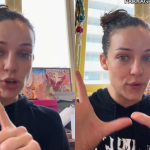
Dear fellow non-skinny legends, I regret to inform you that low-rise jeans are back in fashion. Models Bella Hadid and Andrea Billantes have been spotted wearing them, and searches for them in Europe have increased by 73% in the last 12 months, according to The Guardian.
And, while I by no means aim to criticise people who want to wear them, the resurgence of low-rise jeans puts forth an important question from the Y2K era that seems to still be an issue today. When will fashion trends be size-inclusive from the fucking get-go?
Because, my good girls, gays, and theys, I for one am tired of spending hours looking for a “plus-size” version of a style that’s trending on Depop.
The Problem With Fashion Trends Like Low-Rise Jeans
When it comes to skinny privilege in fashion, low-rise jeans are It. Where baggy, oversized pants help accentuate hips and butts and work with all types of bodies, low-rise jeans accentuate extreme thinness and petit waists, and—here’s the real kicker—are designed for people with toned and slim bellies.
Sure, people will say you can wear whatever you want and can pull off anything as long as you have the ~confidence~, but, as someone with a tum, lemme just say that low-rise jeans are specifically Not It. They’re just not made for people like me.
In fact, for people with a belly, all low-rise jeans do is emphasise you have a gut, and not in the cute ‘sun’s out tums out’ kinda way that a crop top does. No joke, the sheer idea of wearing one is atomically setting off my body image insecurities right now.
It’s for this reason that people, namely, millennials who lived through the original low-rise trend in their childhood, are worried. With the return of the trend comes the same body dysmorphia that existed around that era with it. Our bodies are being commodified as a fashion statement again and with that comes a whole new range of body image issues for a new generation.
As TikToker Colin McCarthy put it best in a video explaining why people were concerned about the trend coming back: “[with] the low-rise pants, skirt, and shorts that were popular—[from people like] Paris Hilton during [her] The Simple Life era— your body was the fashion.
“The clothes were so casual, it was like a T-shirt and jeans. You weren’t showing off what you were wearing, you were showing off your stomach. If you wore anything about a size two you were ‘fat.’”
@theprincessandthepoppers #feminism #bodyimage #millennial #early2000sfashion #y2kfashion #genz #genzvsmillennial
And look, low-rise jeans aren’t the only style culprit within the fashion world that feels size-exclusive but they are the one that’s gaining the most attention right now. In 2021, they’re the best example of the industry creating a trend that’s so unapologetically exclusionary.
Why Can’t Plus-Sized And Non-Sample-Sized People Get Into Fashion Without It Being A Political Statement?
When new styles first begin trending, they’re often catered to a specific person and with a specific size in mind. Often, these proposed sizes are either divorced from reality and have been linked to eating disorders.
In an episode of Australian Story in 2016, Chelsea Bonner, the founder of a plus-size modeling agency, pointed out that the average waist size of Australian women is around a size 14 or 16. And, as a quick squiz online will remind you, the average sizes offered in most online retailers end at around size 18.
So, what are the people who fit into a size 20 or greater supposed to do if they want to try a new trend and find out that the clothes for it aren’t made for their size? Even worse, what are they supposed to do when these new styles originally made for slim bodies make their way to the “plus-size” community, and people outside of it feel the need to make a big point about it?
Well, if they do participate in a new fashion trend traditionally not made for people with their body shape, they’re labeled as political activists instead of fkn fashion icons.
Whenever someone like Lizzo drops a fire pic of her in a thong, half of the comments are disgusted while the other half praise her as a body-positive queen. Standing next to fashion icon Harry Styles, she’s not seen as a fellow stylish model but, bizarrely, as an activist.
Then, think of Billie Eilish. When she debuted a bomb dot com dot au photoshoot in British Vogue in a corset-bra, it became a point of conversation. Some fans saw it as merely a symbol of the Gen Z style icon’s new era of music, but others either critiqued her for doing it, or called her “brave” for going outside of her visual comfort zone. A comfort zone, mind you, that she has been put in by the tabloids.
Would we treat a skinny performer with even a handful of their credentials the same way? Tragically, I think not.
As Someone New To Fashion, Seeing This Trend Brings Back Old Trauma Of Feeling Like I Don’t Belong
Even beyond the celebrities harrowed as body-positive activists and dealt by the wrath of the fashion gods, this story’s personal.
Growing up, I never cared about how I dressed or what I put on. My usual go-to clothes would be a gross anime-printed and most likely food-smudged T-shirt off Redbubble, a pair of black tracksuit pants, and a hoodie. Category is undeniably cursed raccoon midway deep in a garbage bin realness.
Going to an all-boys school with a proper suit and tie uniform, I wasn’t experimental with my fashion outside of school. It wasn’t so much that I didn’t want to wear nice clothes, I was just raised in a society that didn’t teach that I was *allowed* to.
But, when 2020 invited cis-gendered men to wear skirts and crop tops and play around with the makeup, and as the gendered barriers of fashion began to shatter, I, for the first time in my life felt included in the world of fashion. Over the course of the year, I slowly began investing in high-waisted pants, bright and boldly coloured patterns, and colour-blocked outfits, moving along to crop-tops, skirts, and then corsets.

Thanks to the cultural shift towards vintage fashion and the TikTok community embracing men being feminine, I discovered my own sense of style and on the way, helped rekindle my self-confidence when it was at its lowest. All of a sudden, I learned to care about how I looked and presented to myself and the world.
I owe a lot of my recent journey in self-discovery and embracing my queerness to my growing wardrobe. In 2021, I make fashion a part of my self-expression. But, with the return of size-exclusive trends like low-rise jeans, I’m afraid that I’ll be left out of the wonderful world of fashion again.
The world of fashion is finally embracing the idea that boys and masculine-presenting people can wear feminine clothing. But, when will it be time to do the same for plus-sized people wearing skinny-coded clothing?
If you are someone that owns a pair of low-rise jeans and can rock them then great, good for you. I’m not criticising the people who can participate in these fashion trends. I’m merely criticising the tastemakers who put forth these ideas into the world and do so with only skinny people in mind.



